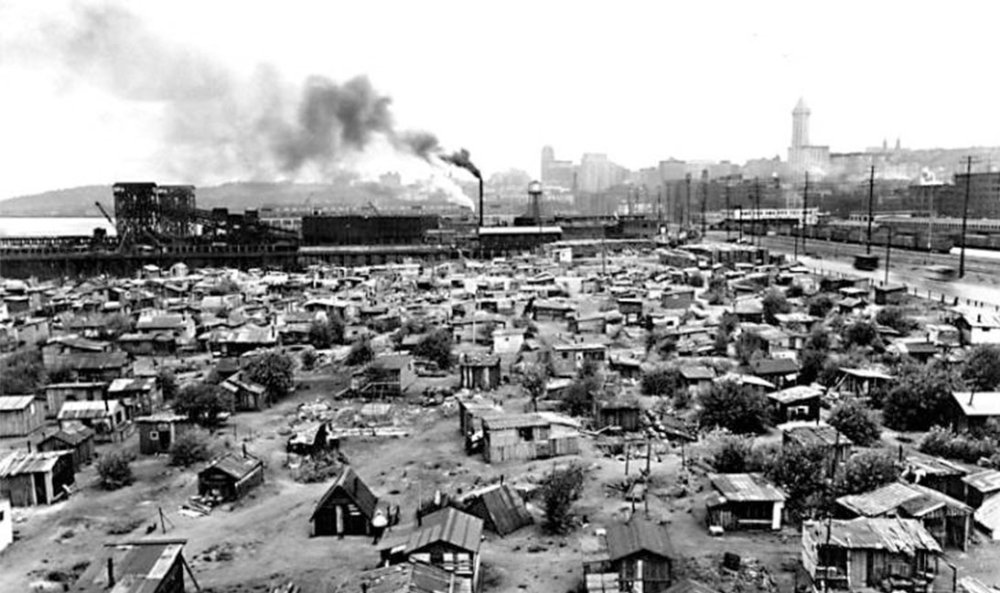Bruce Ramsey was a respected longtime business reporter for the Seattle P-I, and then an opinion journalist for the editorial page of The Seattle Times. Now, in addition to writing for Post Alley, Ramsey is researching and writing local history books. In addition to his fascinating book about the 1893 Depression in this region, The Panic of 1893, he has just published a valuable new book, Seattle in the Great Depression (WSU Press).

True to his roots as a journalist, Ramsey’s new book has a subtitle that reflects the author’s use of daily papers as the main source for his new history. This is explained as “history from the bottom up,” a fascination for local history that harks back to Murray Morgan’s Skid Road (1951), which told of lowlife characters such as Dave Beck and Doc Maynard. Also in this tradition is Seattle From the Margins (2022) by Megan Asaka, with its tight focus on casual labor pools.
Using newspaper coverage as his guide to the 1930s, Ramsey’s book is full of the anecdotes that caught the eyes of editors in daily journalism. Like the newspapers, there is built-in suspense, since editors don’t know about future developments and elections. Ramsey’s business journalism means that the book is also full of developers and financial details whose loans and bonds powered the surge of building in the 1920s and up to the early Depression.
It is not an interpretive history, but certain themes come through clearly, notably the flirtation with the Utopian Left and with Dave Beck’s high-wage, low-growth cartelism in the 1930s. Those ventures fizzled out after World War II, with the arrival of the Boeing Decades and the post-War boom, anchored by the Magnuson-Scoop-Ellis-Evans consensus.
For Ramsey, the Depression “postponed the vision [of Seattle’s emergence] by several decades.” It was a detour into magical thinking, Russophilia, Utopian Leftism of the Commonwealth Federation, and the alarming proto-fascism led by Dave Beck’s “little NRA,” and his ally Mayor John Dore.
The seeds of leftism were planted for later flourishing, but it was the business-led moderation of Mayor Art Langlie (who trounced the Harvard-educated John Dore in 1938), which led to the growth-dominated politics of Dan Evans, Slade Gorton, and the enduring political establishment set in place by Mayor Wes Uhlman. Nonetheless, that dream of socialism in the 1930s still haunts the politics of the Left Coast.
Ramsey’s year-by-year account turns up all kinds of surprising details. We learn of the crucial role of Ben Ehrlichman (John Ehrlichman’s uncle) in floating bonds in that debt-fueled era of rapid growth. Also, business interest in trade with Russia as a nearby nation. How the Huskies were once called the Sun Dodgers; an early effort to use Seward Park as a bridge to the Eastside; the various left-wing weeklies, even a labor college as Seattle flirted with becoming a closed-shop Labor-dominated town; an early effort to have City Light buy out Puget Power; and a proposed, grandiose name for Alaskan Way, “Cosmos Quay.”
At times, the 1930s read like a lost decade, since many of the socialist and New Deal movements wane or over-reach. As for newspapers, Ramsey stresses the business orientation of The Seattle Times, led by the strutting C.B. Blethen, and the taming of the P-I with a new publisher married to FDR’s daughter.
I would have liked more attention to the growth of urban neighborhoods, anchored by public schools; Ivar Haglund’s comic version of social movements; and the rise of civic institutions like the Muncipal League and the League of Women Voters. All these trends led to the emergence of a steady, moderate consensus form of politics, 1964-1990, that obviated the false starts of the Depression, and allowed the business visions to regain momentum.
That said, in many ways the 1930s of this book echo many of the cleavages of modern Seattle. In the Depression years, the main split was among progressives — the Leftist Commonwealth Federation and the New Deal liberals. There is the familiar shortage of enduring leadership, and of continuity and building upon success, as the mayor’s office oscillates between radicalism and business-oriented pragmatism.
This valuable, engrossing book provides another chapter of Seattle’s boom-and-bust, war-and-peace history. Self-starting characters briefly hold the stage and few abiding themes prevail and build on history. Thanks to this book, the chaotic 1930s now join that clamorous parade.
Discover more from Post Alley
Subscribe to get the latest posts sent to your email.

I have not read this book, but hope it includes a broader picture of what was going on in Depression-era Seattle than what I can gather from this brief account. Seattle’s Depression-era population total barely moved, birth and marriage rates nationally collapsed, and the dramatic population growth of surrounding rural areas in King County and Western Washington might be attributed to the PR campaign urging desperate city dwellers to find small parcels of land to live on where they could grow their own food. Seattle’s 1930s city government was financed in good measure on tolerating and taxing vice and encouraging police extortion of those businesses.
Meanwhile, business leaders then holding financial Seattle together (with their major real estate assets at risk) were found on the Board of Directors of a property/casualty insurance company founded in 1923 that thrived: General Insurance Company of America, known now as Safeco, organized by Hawthorne K. Dent. A 1980 corporate history written by Sid Copeland offers clues. It must have been the first business board in Seattle that in the Depression included tough rivals – Dorothy Stimson Bullitt, founder of KING Broadcasting, and O.D. Fisher, founder of KOMO Broadcasting. Meanwhile, United Airlines, founded by Seattle’s Bill Boeing, was profitable from its beginning in 1927, and continued to be so throughout the “Great Depression.” Good of Ramsey to open doors on that rough and tumble era in the fight for money and power.